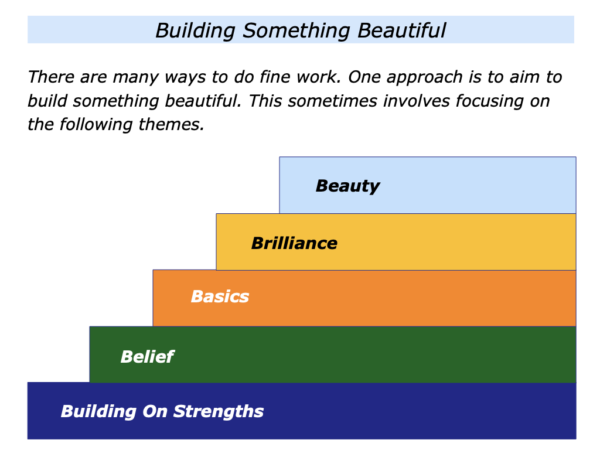
There are many ways to do fine work. One approach is to build on your strengths and do what you believe in. It is then to do the basics, add the brilliance and make something beautiful.
Imagine you want to follow this approach in your own way. This can involve focusing on the following steps.
Building On Strengths
Great workers build on their strengths. They aim to do what they do best and do their best. Imagine that you want to follow this approach in your own way. If appropriate, you can take the following steps.
You Can Clarify Your Strengths
One approach is to start by clarifying one or more of the strengths that you want to build on. If appropriate, clarify the specific activities where:
You have the ability to deliver As rather than Bs or Cs … You are in your element – at ease and yet able to excel … You are doing something you feel passionately about where you can deliver peak performances.
Try to be as specific as possible when clarifying your strengths. Much will depend, of course, on the activity in which you do good work. Let’s look at one example.
Imagine you are good at mentoring. You can aim: a) to define the specific kinds of people with whom you work best; b) the specific things you can do to help these people; c) the specific examples of when you have helped people to achieve their goals.
The same criteria applies to any field where you do good work. Try to clarify the specific things you do to deliver success in that activity. It can then be time to focus on the following theme.
You Can Translate Your Strength
Into Doing A Specific Piece Of Work
Imagine that you have clarified a strength you want to build on. If appropriate, you can translate this into doing a specific piece of work. You may aim, for example:
To encourage a person … To run a workshop … To do a creative project … To provide great service to a client … To build your own business … To lead a team … To shift a culture … To do another activity.
Let’s assume that you have clarified a piece of work you want to do. What may be your reasons for doing this work? What will be the benefits for yourself or other people? You may wish to clarify these by doing the following exercise.
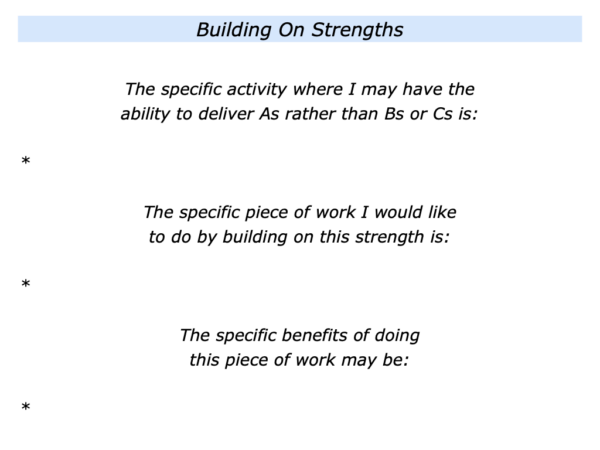
Let’s assume you have done this exercise. If appropriate, you may wish to explore the following theme before moving into action.
Belief
Great workers do what they believe in. Bearing in mind what they can control in the situation, they aim: to a) to set goals they believe they can achieve; b) to follow principles they believe in. Let’s explore these themes.
You can set goals that you
believe are possible to achieve
This involves taking a certain approach to setting goals. Bearing in mind your own abilities – and what you can control – you can set goals that you believe are possible to achieve.
Here is an exercise on this theme. This invites you to clarify the specific things that you believe: a) you can achieve; b) you maybe can achieve; c) you probably can’t achieve. This involves doing a reality check rather than being defeatist. Try working through the following themes.
Clarifying The Specific Goals
The specific piece of
work I want to do is:
*
Can Achieve – The specific
things I can achieve are:
*
*
*
Maybe Can Achieve – The specific
things I maybe can achieve are:
*
*
Can’t Achieve – The specific
things I probably can’t achieve are:
*
Bearing in mind what you believe you can achieve, it can be useful to focus on the following theme.
You can clarify the principles you believe in following
when working towards achieving the specific goals
Great workers believe in following certain principles when working to achieve their goals. Some aim to build on their strengths, follow strategies that work and do their best to achieve the picture of success.
Some people follow other principles. They may base these on either:
The philosophy they believe in about how to help people, do the work or achieve the specific goal;
The principles they have followed in the past to achieve success when working to achieve a similar goal;
The professional standards they believe in following when doing their best to achieve a specific goal.
The principles they follow will obviously depend on the kind of work they are doing. They may be working as an educator, nurse, carpenter, scientist, leader or in another role.
Let’s return to the piece of work you want to do. Bearing in mind what you can control in the situation, try answering the following questions.
What are the real results you want to achieve? What will be happening that will show you have achieved these results? What will be the picture of success?
What are the principles you want to follow when doing the piece of work? How can you translate these into action? How can you do your best to deliver the desired results?
Bearing in mind what you can control, what is the probability of success? On a scale 0-10, how would you rate the chances of achieving the results? What can you do to maintain or improve the rating?
Let’s try pulling all these things together. If you wish, try tackling the following exercise.
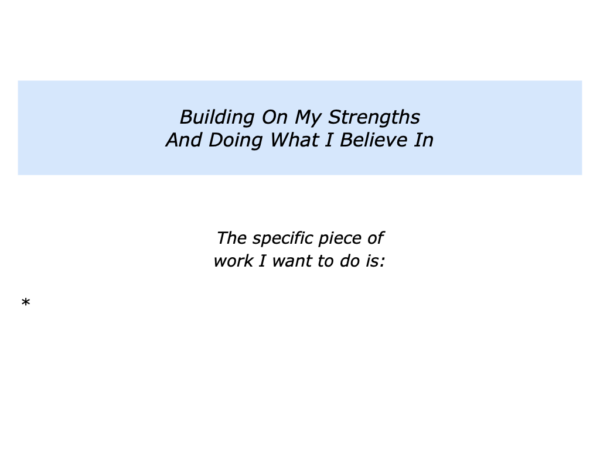
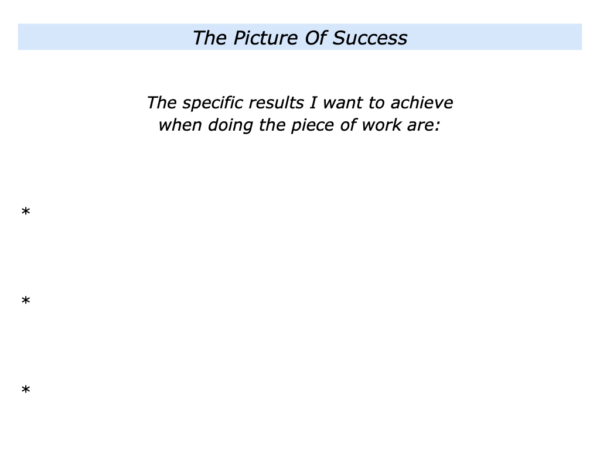
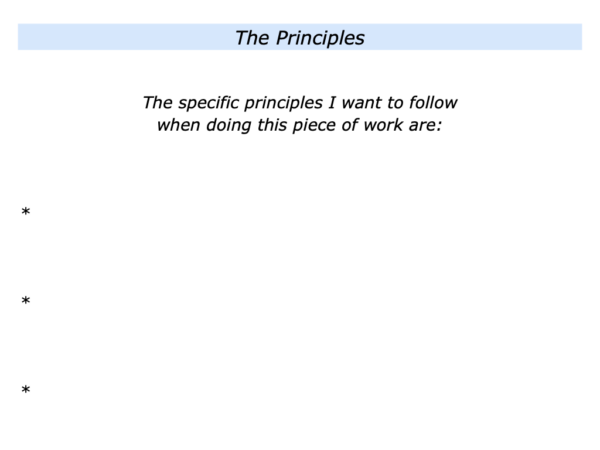
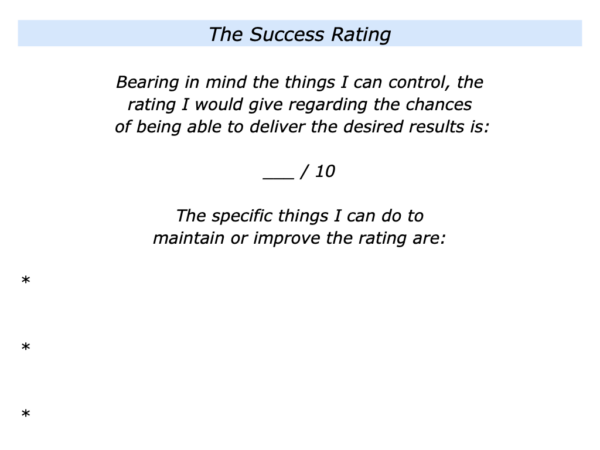
Imagine that you are ready to move into action. This can involve focusing on the following theme.
Basics
Great workers keep doing the basics that are required to provide the platform for doing brilliant work. They often take the following steps.
They keep following their principles – such as following strategies work – on the way towards achieving the picture of success;
They keep delivering high professional standards when working towards the picture of success;
They keep embodying the concept of continuous improvement when working towards the picture of success.
Different people will perform different basics to reach their goals. The way they translate these into action depend on whether they work in sports, business, hospitality, medical care, therapy, technology or whatever.
A counsellor will help a person to feel at ease, explore what they want to achieve and then enable them to shape their future. An athlete will prepare properly – both physically and psychologically – and then do their best to achieve peak performance.
Let’s return to your chosen work. What are the basics you need to do to create the platform for achieving success? How can you continue to maintain high professional standards? How can you translate these into action?
If you with, try tackling the exercise on this theme. Bearing in mind the piece of work you want to do, this invites you to complete the following sentence.
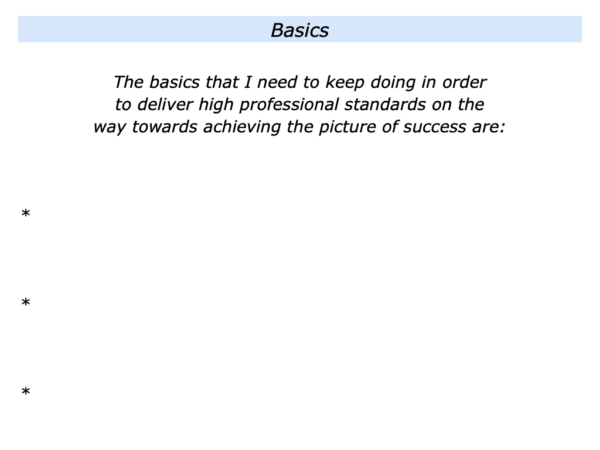
Brilliance
Great workers sometimes add the brilliance. A footballer may use their skills to make a defence-splitting pass or score a remarkable goal. A surgeon may use their gifts to perform a life-saving operation in difficult circumstances.
Different people add the brilliance in their own ways. One approach is for them to keep delivering high standards. It is then to use their strengths to do something special to achieve the picture of success.
As simple as it sounds, one way to add the brilliance can be by being kind. This can help to create positive memories for life. Let’s explore this approach that builds on work of Piero Ferrucci.
He is a psychotherapist who has spent much of his career helping people to live fulfilling lives. He has also written many books, including The Power of Kindness and Beauty and the Soul.
Piero believes in the benefits of kindness, both for the giver and the receiver. Paul also says that, despite many headlines about cruelty, millions of acts of kindness happen every day. He explains this in the following way.
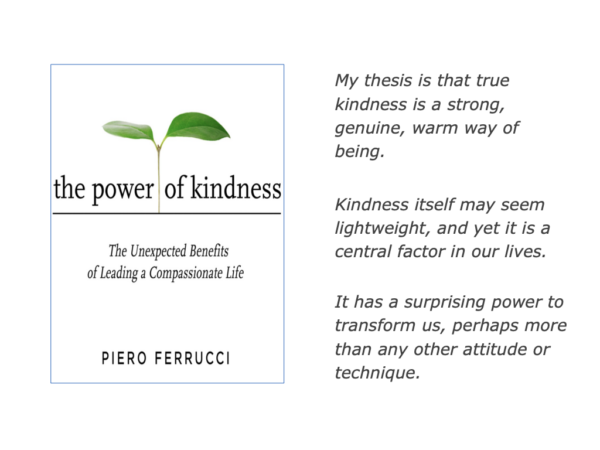
However special it may sound it (kindness) is by no means exceptional. On the contrary, it comprises a great deal of human interactions.
The fabric of our lives is made of care, solidarity, mutual service. These qualities are so embedded in our daily events that we may not even notice them.
Piero believes that kindness can help future generations. He encourages us to care for the planet in the following way.
Kindness is urgent in our relationship with our living environment. If we do not respect and love nature, do not treat her with loving kindness and the awe she deserves, we will end up intoxicated by our own poisons.
It is up to us. It is a choice in the life of each of us – to take the way of selfishness and abuse, or the way of solidarity and kindness. In this exciting but dangerous moment of human history, kindness is not a luxury, it is a necessity.
Being kind is taking a stand. By itself it may not help: Maybe our kindness will be ineffective. Never mind. We have affirmed a principle, a way of being.
Piero believes that many people feel better when they are kind. He explains this in the following way.
If we are healthier when we are caring, empathic, and open to others, it means we were born to be kind. If we push our way forward, cultivate hostile thoughts, or bear life-long grudges, we will not be at our best.
And if we ignore or repress our positive qualities, we may harm ourselves or others. As psychiatrist Alberto Alberti maintains, love that is not expressed becomes hate, joy that is not enjoyed become depression. Yes, we are designed to be kind.
My thesis is that true kindness is a strong, genuine, warm way of being. Kindness itself may seem lightweight, and yet it is a central factor in our lives. It has a surprising power to transform us, perhaps more than any other attitude or technique.
Let’s return to your own work. You will, of course, use your strengths to add the brilliance in your own way. This can also help to create a positive memory for life.
If you wish, try tackling the exercise on this theme. Bearing in mind the piece of work you are doing, this invites you to complete the following sentence.
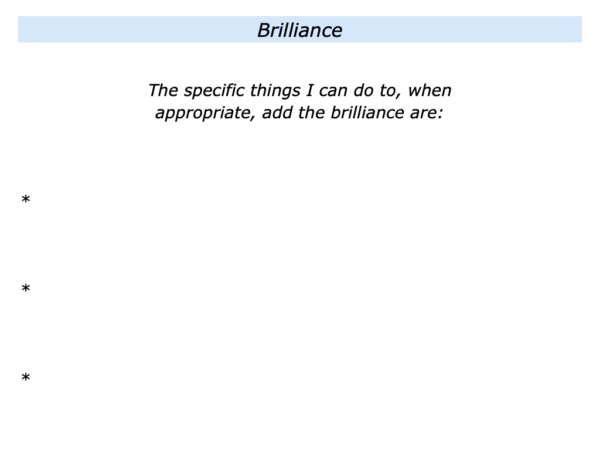
Beauty
Great workers may go beyond doing brilliant work. They may also aim to make it beautiful. There are many definitions of beauty. Some people follow the principles of great design.
They create something that is simple, satisfying and successful. It is simple but in a profound way. It is satisfying both an aesthetic and practical level. It is successful. It works and helps people to get positive results.
Let’s return to the work of Piero Ferrucci, who believes in the power of beauty. He says that all of us, in one way or another, seek beauty. We know it brings happiness and wellbeing.
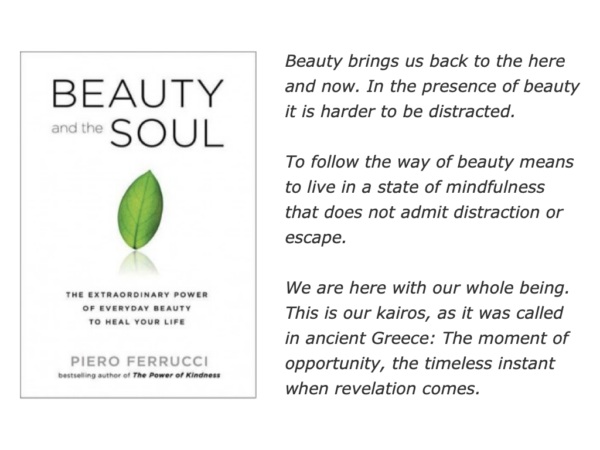
Beauty is in the eye of the beholder. A person may experience beauty in nature, art, music, theatre, sport, mathematics or another activity. Piero describes this in the following way.
Some manage to see the inner beauty of people: generosity, intelligence, honesty. It is a beauty less evident, but deeper and more lasting.
Beauty can help us to heal, feel alive and open our eyes, says Piero. It can help us to reconnect with our feelings, connect with other people and discover new dimensions.
Beauty is more than an extra, it is a basic. It is also the perfect medicine, says Piero. Its side effects are positive rather than negative. This is certainly true when it comes to people. He explains this in the following way.
Moral beauty is alive and well. In fact both kinds of beauty exist – outer and inner. The former is more obvious, more likely to attract attention, more immediate, gratifying and short-term.
The latter is subtler, deeper, usually needs more time to be perceived. And often it is not fully disclosed to the distracted eye. Physical beauty is a sprinter – it covers short distances faster. Beauty of the soul is a marathoner – it shows up over long distance.
Piero describes many studies that show the tangible benefits of beauty in schools, hospitals, workplaces and society. Beauty nourishes the soul, says Piero, but it goes further. Beauty may also be necessary for our survival as a species. It enables us to experience a sense of wonder and, when we wish, also create beautiful things.
There are many ways to do fine work. One approach is to build on your strengths and do what you believe in. It is then to do the basics, add the brilliance and, when appropriate, make things beautiful.
Let’s return to the piece of work you want to do. If you wish, try tackling the final exercise on this theme. This invites you to describe how you may aim to make the work beautiful.
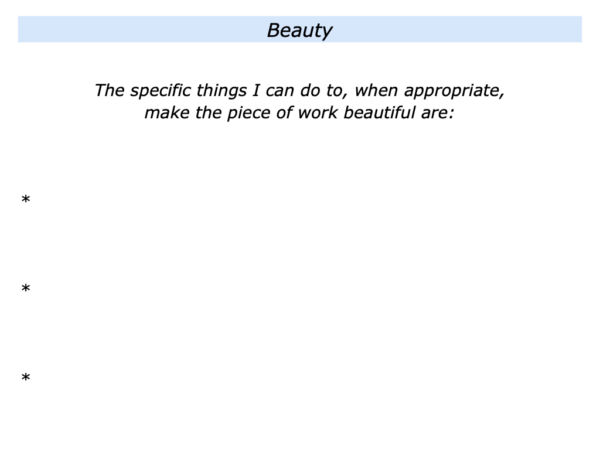


Leave a Reply